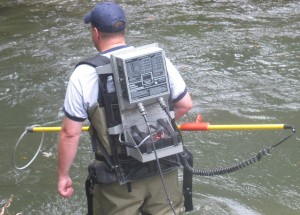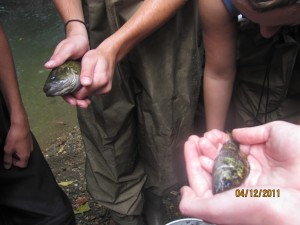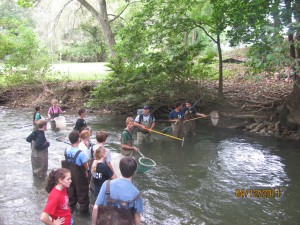By Eric Schlotzhauer and Matthew Hatch –
Fishing has never been so shocking.
Penn Manor’s AP environmental science class went on a field trip electrofishing in the Little Conestoga River on Monday, but left their hooks, rods and bait at home.
Matt Kofroth, a watershed specialist, and an employee for the Lancaster County Conservation District directed the students on how to electrofish and taught them the safety precautions and then navigated with his battery pack that electrocuted the fish.

Erick Dutchess, the AP Environmental Science teacher for Penn Manor, is the man in charge for setting up the trip to Charlestown Park.
The educational goal of the trip was to find out what kind of fish inhabit the Little Conestoga. With the recent flooding that Pennsylvania has experienced, the students weren’t too sure what they would find.
Students wore water waders so they wouldn’t get shocked and their clothes wouldn’t get wet. The pants came up to their chest and had overall-like buckles.
The battery pack is just like the batteries used at home, except a lot bigger, a lot more powerful and a lot more dangerous. Two-hundred watts of electricity surge through the metal wand used to charge the water.
The fish remain stunned for a short-time due to the low wattage of the machine. A different machine can shock the fish with 500-watts, keeping fish stunned much longer.
In every battery, there is a positive and a negative end. The negative end, in this case, is a long rubber tail hanging off the pack. The positive end is the metal wand. When the machine is turned on, anything within five feet of the water will be shocked, including any bare skin.
“They only get hurt if the metal ring touches the fish,” said Kofroth. “They get burned.”

Suckers, cut-lip minnows, shiners, chubs and rock-bass were the fish the students found during their trip. After the students determined what kind of fish they were, they put them back into the water due to the requirements of owning a license to electrofish.
Students enjoyed the learning experience about the communities and ecosystems in the Little Conestoga.
“It was a new experience,” said Penn Manor senior Amanda Nolt.
“It was a fun and easy way to catch a fish,” explained senior Nicole Harnish.
While most students had fun, others weren’t too thrilled with the outcome of the trip.
“I fell in,” said senior Jenn Rote. “I was really surprised”
“It was freezing” said Ian Toomey.
Among these two students, junior Anthony Crognale also took a plunge.

By the end of the trip, no students were shocked by the battery, and no fish were killed.
Due to expenses and difficulty in getting equipment, electrofishing isn’t a common event outside of the Conservation District.
To go electrofishing equipment is expensive ranging from $5,000 to $10,000.
Also required:
- a license to purchase the equipment
- water waders to enter the water without getting shocked
- nets to catch the shocked fish
- a lot of patience
Dutchess has been taking his students electrofishing for two years (since he started teaching environmental science) and he plans on continuing the tradition.
“Not everyone gets the chance to zap fish with a car battery,” said Dutchess. “Hopefully it was a novel experience that they’ve never done before.”
To find out more about electrofishing you can visit:http://www.fishandboat.com/images/fisheries/afm/electro/electro.htm
Hello, I read your blogs on a regular basis. Your writing style is awesome, keep up the good work!